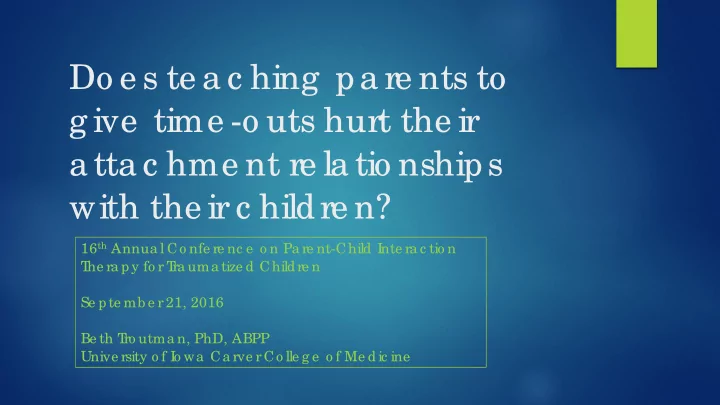

Do e s te a c hing pa re nts to g ive time -o uts hurt the ir a tta c hme nt re la tio nships with the ir c hildre n? 16 th Annua l Co nfe re nc e o n Pa re nt-Child I nte ra c tio n T he ra py fo r T ra uma tize d Childre n Se pte mb e r 21, 2016 Be th T ro utma n, PhD, ABPP Unive rsity o f I o wa Ca rve r Co lle g e o f Me dic ine
Ove rvie w A little the o ry A little c linic a l a pplic a tio n A little da ta
A little the o ry
“But the b ig g e st re a so n we q ue stio n the va lue o f time - o uts ha s to do with a c hild’ s pro fo und ne e d fo r c o nne c tio n.” “Yo u do n’ t wa nt to se nd the me ssa g e tha t yo u’ ll b e in re la tio nship with he r whe n she ’ s “g o o d” o r ha ppy, b ut yo u’ ll withho ld yo ur lo ve a nd a ffe c tio n whe n she ’ s no t.” Sie g e l & Bryso n, 2014, No -Dra ma Disc ipline
Why my tra ining a nd re se a rc h in a tta c hme nt the o ry ma ke s me ne rvo us a b o ut time -o uts T he re is a pro fo und ne e d fo r c o nne c tio n. Se c ure a tta c hme nt is a sso c ia te d with b e tte r e mo tio na l re g ula tio n. Co nc e rn tha t time -o ut ma y le a d to mo re a vo ida nt stra te g y fo r c o ping with distre ss.
Organized Patterns of Attachment INSECURE SECURE INSECURE A1 A2 B other B1 B3 B4 B other C2 C1 avoidant- avoidant- secure- very secure secure- dependent ambivalent- ambivalent- ignoring neutral reserved secure-feisty resistant immature secure-controlling Focus on attachment Focus on exploration Balance between and independence attachment & exploration relationship/affect
safe haven secure base
independence relationship
independence relationship
relationship independence
Attachment and Emotional Regulation co-regulation self-regulation open expression of distress
Attachment and Emotional Regulation heightening distress co-regulation
Attachment and Emotional Regulation minimizing distress self-regulation
(Integration of Working Models of Attachment into Parent-Child Interaction Therapy) state of skills mind
pattern behavior of attachment
A little da ta
• Is there research on time-out and attachment using well-validated assessments of attachment security? • No
• Is there research on post-PCIT outcomes using well-validated assessments of attachment security? • No
Attachment Prior to IoWA-PCIT INSECURE SECURE INSECURE X X X X X X X A1 A2 B other B1 B3 B4 B other C2 C1 avoidant- avoidant- secure- very secure secure- dependent ambivalent- ambivalent- ignoring neutral reserved secure-feisty immature resistant secure-controlling Focus on relationship Focus on exploration Balance between & independence attachment & exploration minimization of distress open expression of distress heightening of distress
Attachment Following IoWA-PCIT (Including Teaching Parents to Use Time-Outs) INSECURE SECURE INSECURE X X X X X X X A1 A2 B other B1 B3 B4 B other C2 C1 avoidant- avoidant- secure- very secure secure- dependent ambivalent- ambivalent- ignoring neutral reserved secure-feisty immature resistant secure-controlling Focus on relationship Focus on exploration Balance between & independence attachment & exploration minimization of distress open expression of distress heightening of distress
Co ntinuo us Atta c hme nt Ra ting s Pr e - IoWA- PCIT Post- IoWA- PCIT E ffe c t size Se c urity (sc a le B) 5.4 (1.0) 6.4 (.8) 1.1* Avo ida nc e (sc a le A) 2.5 (1.8) 1.4 (.9) -.8 Re sista nc e (sc a le C) 2.5 (1.7) 1.7 (.7) -.6
Did te a c hing pa re nts to g ive time - o uts hurt the ir a tta c hme nt re la tio nships with the ir c hildre n in the se fa milie s? No no ne o f the fa milie s ha d le ss se c ure re la tio nships with the ir c hildre n a fte r pa re nts we re ta ug ht to use time -o ut
Do we ne e d mo re re se a rc h o n the impa c t o f time -o uts a nd PCI T o n a tta c hme nt? Ab so lute ly
Recommend
More recommend